by Calculated Risk on 2/13/2022 10:37:00 AM
Sunday, February 13, 2022
3rd Look at Local Housing Markets in January
Today, in the Calculated Risk Real Estate Newsletter: 3rd Look at Local Housing Markets in January
A brief excerpt:
Adding Albuquerque, Atlanta, Colorado, Georgia, Jacksonville, Minnesota, Sacramento, Santa Clara and South CarolinaThere is much more in the article. You can subscribe at https://calculatedrisk.substack.com/
...
Here is a summary of active listings for these housing markets in January. Inventory was down 10.3% in January month-over-month (MoM) from December, and down 27.9% year-over-year (YoY).
Inventory almost always declines seasonally during the Winter, so the MoM decline is not a surprise. Last month, these markets were down 26.5% YoY, so the YoY decline in January is slightly larger than in December. This isn’t indicating a slowing market
Notes for all tables:
1. New additions to table in BOLD.
2. Northwest (Seattle), North Texas (Dallas), and Santa Clara (San Jose), Jacksonville, Source: Northeast Florida Association of REALTORS®
3. Totals do not include Denver and Atlanta (included in state totals).
Saturday, February 12, 2022
Real Estate Newsletter Articles this Week
by Calculated Risk on 2/12/2022 02:11:00 PM
At the Calculated Risk Real Estate Newsletter this week:
• The Impact on Housing of Higher Mortgage Rates
• 2nd Look at Local Housing Markets in January Adding Houston, Memphis, Nashville, New Hampshire, North Texas and Portland
• Black Knight Mortgage Monitor for December "Worst affordability levels since 2008"
• 1st Look at Local Housing Markets in January Denver: "the market ended with ... over 10 times less inventory than normal"
This is usually published several times a week, and provides more in-depth analysis of the housing market.
You can subscribe at https://calculatedrisk.substack.com/ Most content is available for free, but please subscribe!.
Schedule for Week of February 13, 2022
by Calculated Risk on 2/12/2022 08:11:00 AM
The key reports this week are January Housing Starts, Retail sales and Existing Home sales.
For manufacturing, the January Industrial Production report, and the February NY and Philly Fed manufacturing surveys will be released this week.
No major economic releases scheduled.
8:30 AM ET: The Producer Price Index for December from the BLS. The consensus is for a 0.5% increase in PPI, and a 0.5% increase in core PPI.
8:30 AM: The New York Fed Empire State manufacturing survey for February. The consensus is for a reading of 12.0, up from -0.7.
7:00 AM ET: The Mortgage Bankers Association (MBA) will release the results for the mortgage purchase applications index.
 8:30 AM: Retail sales for January is scheduled to be released. The consensus is for a 1.8% increase in retail sales.
8:30 AM: Retail sales for January is scheduled to be released. The consensus is for a 1.8% increase in retail sales.This graph shows retail sales since 1992. This is monthly retail sales and food service, seasonally adjusted (total and ex-gasoline).
Retail sales ex-gasoline were down 2.0% in December.
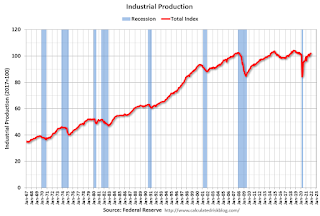 9:15 AM: The Fed will release Industrial Production and Capacity Utilization for January.
9:15 AM: The Fed will release Industrial Production and Capacity Utilization for January.This graph shows industrial production since 1967.
The consensus is for a 0.4% increase in Industrial Production, and for Capacity Utilization to increase to 76.7%.
10:00 AM: The February NAHB homebuilder survey. The consensus is for a reading of 82, down from 83. Any number above 50 indicates that more builders view sales conditions as good than poor.
2:00 PM: FOMC Minutes, Meeting of Jan. 25-26
8:30 AM: The initial weekly unemployment claims report will be released. The consensus is for a decrease to 222 thousand from 223 thousand last week.
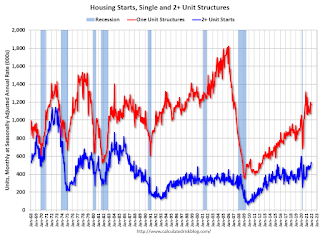 8:30 AM: Housing Starts for January.
8:30 AM: Housing Starts for January. This graph shows single and multi-family housing starts since 1968.
The consensus is for 1.700 million SAAR, down from 1.702 million SAAR.
8:30 AM: the Philly Fed manufacturing survey for February. The consensus is for a reading of 20.0, down from 23.2.
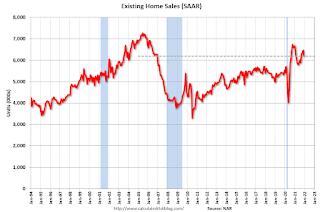 10:00 AM: Existing Home Sales for January from the National Association of Realtors (NAR). The consensus is for 6.12 million SAAR, down from 6.18 million.
10:00 AM: Existing Home Sales for January from the National Association of Realtors (NAR). The consensus is for 6.12 million SAAR, down from 6.18 million.The graph shows existing home sales from 1994 through the report last month.
Friday, February 11, 2022
COVID Update: February 11, 2022: Falling Cases, Deaths and Hospitalizations
by Calculated Risk on 2/11/2022 10:03:00 PM
On COVID (focus on hospitalizations and deaths):
| COVID Metrics | ||||
|---|---|---|---|---|
| Now | Week Ago | Goal | ||
| Percent fully Vaccinated | 64.3% | --- | ≥70.0%1 | |
| Fully Vaccinated (millions) | 213.6 | --- | ≥2321 | |
| New Cases per Day3 | 190,401 | 344,320 | ≤5,0002 | |
| Hospitalized3 | 95,642 | 121,845 | ≤3,0002 | |
| Deaths per Day3 | 2,305 | 2,419 | ≤502 | |
| 1 Minimum to achieve "herd immunity" (estimated between 70% and 85%). 2my goals to stop daily posts, 37-day average for Cases, Currently Hospitalized, and Deaths 🚩 Increasing 7-day average week-over-week for Cases, Hospitalized, and Deaths ✅ Goal met. | ||||
 Click on graph for larger image.
Click on graph for larger image.This graph shows the daily (columns) and 7-day average (line) of positive tests reported.
Lawler: Deaths by Age
by Calculated Risk on 2/11/2022 05:01:00 PM
From housing economist Tom Lawler: (CR Note: This is valuable demographic data)
Provisional data from the CDC indicate that there have been 3,427,882 US deaths reported for 2021 as of 2/9/2022, up from 3,383,729 deaths in 2020. Because of reporting delays in some parts of the country the 2021 final death numbers will be a little bit higher that the numbers in the 2/9 report.
CDC also reports provisional death counts by age groups, and below is a table showing 2021 deaths reported so far by age compared to final death counts by age for 2020 and 2019.

Missing Workers by Age Group
by Calculated Risk on 2/11/2022 02:09:00 PM
Note: This is an update to an earlier post.
Back in November, Goldman Sachs economists put out a research note on the labor force participation rate: Why Isn’t Labor Force Participation Recovering?
While the unemployment rate continues to fall quickly, labor force participation has made no progress since August 2020. ... Most of the 5.0mn persons who have exited the labor force since the start of the pandemic are over age 55 (3.4mn), largely reflecting early (1.5mn) and natural (1mn) retirements that likely won’t reverse. The outlook for prime-age persons who have exited the labor force (1.7mn) is more positive, since very few are discouraged and most still view their exits as temporary.
The jobs number comes from Current Employment Statistics (CES: payroll survey), a sample of approximately 634,000 business establishments nationwide.
These are very different surveys: the CPS gives the total number of employed (and unemployed including the alternative measures), and the CES gives the total number of positions (excluding some categories like the self-employed, and a person working two jobs counts as two positions).
 Click on graph for larger image.
Click on graph for larger image.This data is comparing January 2022 to January 2020, using Not Seasonally Adjusted (NSA) data (I compared to January 2020 to minimize the seasonal impact when using NSA data).
Almost all of the missing employed workers - by this method - are in the 25 to 29 and 45 to 49 age groups, and most are women.
Note: this is over a 2-year period, and there have been some demographic shifts between cohorts.
This data would suggest most of the missing workers are prime age (or some took early retirement).
Q1 GDP Forecasts: Slightly Positive
by Calculated Risk on 2/11/2022 11:28:00 AM
Here are a few early forecasts for Q1 GDP.
From BofA:
1Q GDP tracking estimate to 2.0% qoq saar [February 4 estimate]From Goldman Sachs:
emphasis added
We left our Q1 GDP tracking estimate unchanged at +0.5% (qoq ar). We also left our past-quarter GDP tracking estimate for Q4 unchanged at +7.1% (qoq ar). [February 9 estimate]And from the Altanta Fed: GDPNow
The GDPNow model estimate for real GDP growth (seasonally adjusted annual rate) in the first quarter of 2022 is 0.7 percent on February 9, unchanged from February 8 after rounding. After this morning’s wholesale trade release from the US Census Bureau, the nowcast of the contribution of inventory investment to first-quarter real GDP growth decreased from -2.40 percentage points to -2.41 percentage points. [February 9 estimate]
Lawler: Update on US Demographic Drivers in 2021
by Calculated Risk on 2/11/2022 09:02:00 AM
From housing economist Tom Lawler: Update on US Demographic Drivers in 2021
Births: Provisional data from the CDC show that US births totaled 978,000 in the third quarter of 2021, up 2.8% from the comparable quarter of 2020. While births in the first nine months of 2021 were down 0.18% from the comparable period of 2020, the trend in births began increasing in the second half of last year. Assuming this trend continued through last quarter – and adjusting for the normal seasonal pattern of births – a “best guess” for total US births in 2021 would be about 3.64 million. That level would be about 0.7% above 2020’s historically low level, though it would still be the second lowest annual number of births since 1981.
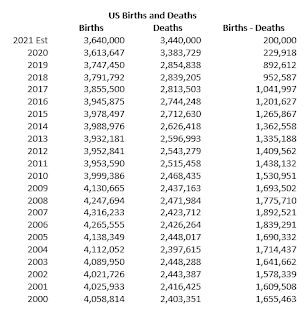
Net International Migration: While there are no timely data on net international migration, there are some indicators that suggest that US immigration increased significantly in the second half of last year from the incredibly low levels of the previous 18 months.

The U.S Department of State’s data on monthly immigrant visa issuance show that such issuance, which was incredibly low in the last nine months of 2020 and the first few months of 2021, increased significantly beginning in the Spring of last year.
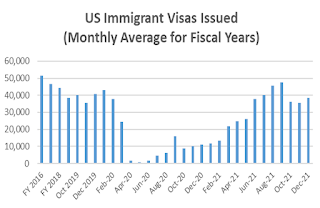
If that were the case, and if the birth and death numbers I showed in the above were correct, then the US resident population last year would have increased by 650,000, or 0.2%. While such growth is historically extremely low, it is actually somewhat higher than the Census estimate for growth from 7/1/2020 to 7/1/2021 (392,665, or 0.1%).
Thursday, February 10, 2022
"Mortgage Rates Hit 4.0% For First Time Since May 2019"
by Calculated Risk on 2/10/2022 09:17:00 PM
From Matthew Graham at Mortgage News Daily: Mortgage Rates Hit 4.0% For First Time Since May 2019
In case it wasn't already clear based on the headline, the average is currently up to 4.02%. Keep in mind that is an average among top tier scenarios. It means that some lenders are quoting 3.625% and others are up to 4.375%. Adding any complexity to the scenario would mean a different rate. Also keep in mind that lenders are MUCH more widely stratified than normal, which is often the case when we've seen as much volatility as we have so far in 2022. [30 year fixed 4.02%]On COVID (focus on hospitalizations and deaths):
emphasis added
| COVID Metrics | ||||
|---|---|---|---|---|
| Now | Week Ago | Goal | ||
| Percent fully Vaccinated | 64.3% | --- | ≥70.0%1 | |
| Fully Vaccinated (millions) | 213.4 | --- | ≥2321 | |
| New Cases per Day3 | 215,418 | 376,855 | ≤5,0002 | |
| Hospitalized3 | 99,535 | 125,219 | ≤3,0002 | |
| Deaths per Day3 | 2,313 | 2,458 | ≤502 | |
| 1 Minimum to achieve "herd immunity" (estimated between 70% and 85%). 2my goals to stop daily posts, 37-day average for Cases, Currently Hospitalized, and Deaths 🚩 Increasing 7-day average week-over-week for Cases, Hospitalized, and Deaths ✅ Goal met. | ||||
 Click on graph for larger image.
Click on graph for larger image.This graph shows the daily (columns) and 7-day average (line) of positive tests reported.
Hotels: Occupancy Rate Down 16% Compared to Same Week in 2019
by Calculated Risk on 2/10/2022 04:27:00 PM
U.S. weekly hotel occupancy eclipsed 50% for the first time in more than a month, but the index to 2019 dipped from the week prior, according to STR‘s latest data through 5 February.The following graph shows the seasonal pattern for the hotel occupancy rate using the four-week average.
Jan. 30 through Feb. 5, 2022 (percentage change from comparable week in 2019*):
• Occupancy: 50.4% (-15.8%)
• Average daily rate (ADR): $125.06 (-1.2%)
• evenue per available room (RevPAR): $63.05 (-16.8%)
*Due to the pandemic impact, STR is measuring recovery against comparable time periods from 2019.
emphasis added
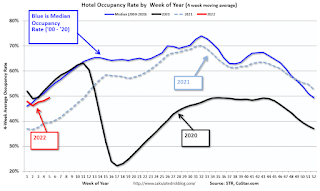 Click on graph for larger image.
Click on graph for larger image.The red line is for 2022, black is 2020, blue is the median, and dashed light blue is for 2021.


